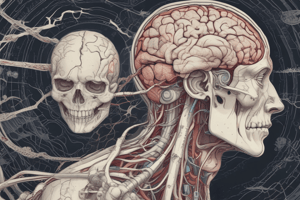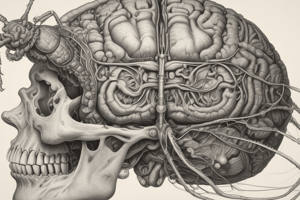Podcast
Questions and Answers
What is the purpose of the reticular formation in the brain?
What is the purpose of the reticular formation in the brain?
- To relay sensory information from the senses to the brain
- To control voluntary movement
- To regulate heartbeat and breathing
- To act as a filter for information and send important data to other brain areas (correct)
What is the main function of the brainstem?
What is the main function of the brainstem?
- To relay sensory information from the senses to the brain
- To act as a filter for information
- To coordinate voluntary movement
- To control basic functions like heartbeat and breathing (correct)
Which part of the brain is responsible for relaying sensory information from the senses to the brain?
Which part of the brain is responsible for relaying sensory information from the senses to the brain?
- Thalamus (correct)
- Reticular formation
- Cerebellum
- Brainstem
What is the impact of damage to the Cerebellum on movement?
What is the impact of damage to the Cerebellum on movement?
What is the location of the Medulla in the brain?
What is the location of the Medulla in the brain?
What is the purpose of the Thalamus in the brain?
What is the purpose of the Thalamus in the brain?
What is the effect of alcohol consumption on the Cerebellum?
What is the effect of alcohol consumption on the Cerebellum?
What is the characteristic of brain evolution and complexity?
What is the characteristic of brain evolution and complexity?
What is the significance of a midsagittal slice of the brain?
What is the significance of a midsagittal slice of the brain?
What is a common characteristic of brain evolution and complexity?
What is a common characteristic of brain evolution and complexity?
What is the primary function of the brainstem?
What is the primary function of the brainstem?
What is the role of the reticular formation in the brain?
What is the role of the reticular formation in the brain?
Which brain structure is involved in coordinating voluntary movement?
Which brain structure is involved in coordinating voluntary movement?
What is a consequence of alcohol consumption on the brain?
What is a consequence of alcohol consumption on the brain?
What is the shape of the Thalamus?
What is the shape of the Thalamus?
What is a result of damage to the Cerebellum?
What is a result of damage to the Cerebellum?
Which part of the brain divides into two parts: Medulla and Pons?
Which part of the brain divides into two parts: Medulla and Pons?
Which brain structure is responsible for filtering information and sending it to the Thalamus?
Which brain structure is responsible for filtering information and sending it to the Thalamus?
What is the primary function of the Cerebellum?
What is the primary function of the Cerebellum?
Which part of the brain is affected by alcohol consumption, leading to coordination issues?
Which part of the brain is affected by alcohol consumption, leading to coordination issues?
What is the result of brain evolution and complexity?
What is the result of brain evolution and complexity?
What is the significance of a midsagittal slice of the brain?
What is the significance of a midsagittal slice of the brain?
What is the role of the Thalamus in the brain?
What is the role of the Thalamus in the brain?
Which part of the brain serves as a crossover point for nerves from the body?
Which part of the brain serves as a crossover point for nerves from the body?
Flashcards are hidden until you start studying
Study Notes
Brain Structure and Function
- The brain can be imagined as a whole, with the front, back, top, and bottom sides, similar to a person's profile.
- A sagittal slice is a type of cutting of the brain, and a midsagittal slice is when it's cut directly through the middle.
Brain Evolution and Complexity
- Brains become more complex as animals evolve, with more developed brains in higher species.
- Despite increasing complexity, older structures are still present, with simpler structures at the center and more complex ones at the outer layers.
Brainstem and Old Brain
- The brainstem is located in the middle of the brain and controls basic functions like heartbeat and breathing.
- It's split into two parts: Medulla and Pons, with the Medulla located at the base of the brain.
- The brainstem serves as a crossover point for nerves from the body, with the right side of the brain controlling the left side of the body and vice versa.
Reticular Formation
- The reticular formation is a structure inside the brainstem, extending into other brain areas.
- It acts as a filter for information, sending important data to other brain areas, specifically the Thalamus.
- It also plays a role in sleep-wake cycles, arousal, and alertness.
Thalamus
- The Thalamus is an egg-shaped structure above the brainstem, relaying sensory information from the senses (except smell) to the brain.
- It's also responsible for relaying information from higher brain areas down to the brainstem and spinal cord.
Cerebellum
- The Cerebellum is a squishy, baseball-sized structure around the brainstem, involved in coordinating voluntary movement.
- It helps with tasks like running and kicking a soccer ball simultaneously.
- Damage to the Cerebellum can cause jerky and awkward movements.
- The Cerebellum is also affected by alcohol consumption, leading to coordination issues.
Brain Structure and Function
- The brain has four sides: front, back, top, and bottom, similar to a person's profile.
- A sagittal slice is a type of cutting of the brain, and a midsagittal slice is when it's cut directly through the middle.
Brain Evolution and Complexity
- Brain complexity increases as animals evolve, with higher species having more developed brains.
- Despite increasing complexity, older structures are still present, with simpler structures at the center and more complex ones at the outer layers.
Brainstem and Old Brain
- The brainstem is located in the middle of the brain and controls basic functions like heartbeat and breathing.
- The brainstem has two parts: Medulla and Pons, with the Medulla located at the base of the brain.
- The brainstem serves as a crossover point for nerves from the body, with the right side of the brain controlling the left side of the body and vice versa.
Reticular Formation
- The reticular formation is a structure inside the brainstem that extends into other brain areas.
- It acts as a filter for information, sending important data to other brain areas, specifically the Thalamus.
- It also plays a role in sleep-wake cycles, arousal, and alertness.
Thalamus
- The Thalamus is an egg-shaped structure above the brainstem that relays sensory information from the senses (except smell) to the brain.
- It relays information from higher brain areas down to the brainstem and spinal cord.
Cerebellum
- The Cerebellum is a squishy, baseball-sized structure around the brainstem involved in coordinating voluntary movement.
- It helps with tasks that require coordination, such as running and kicking a soccer ball simultaneously.
- Damage to the Cerebellum can cause jerky and awkward movements.
- The Cerebellum is also affected by alcohol consumption, leading to coordination issues.
Brain Structure and Function
- The brain has four sides: front, back, top, and bottom, similar to a person's profile.
- A sagittal slice is a type of cutting of the brain, and a midsagittal slice is when it's cut directly through the middle.
Brain Evolution and Complexity
- Brain complexity increases as animals evolve, with higher species having more developed brains.
- Despite increasing complexity, older structures are still present, with simpler structures at the center and more complex ones at the outer layers.
Brainstem and Old Brain
- The brainstem is located in the middle of the brain and controls basic functions like heartbeat and breathing.
- The brainstem has two parts: Medulla and Pons, with the Medulla located at the base of the brain.
- The brainstem serves as a crossover point for nerves from the body, with the right side of the brain controlling the left side of the body and vice versa.
Reticular Formation
- The reticular formation is a structure inside the brainstem that extends into other brain areas.
- It acts as a filter for information, sending important data to other brain areas, specifically the Thalamus.
- It also plays a role in sleep-wake cycles, arousal, and alertness.
Thalamus
- The Thalamus is an egg-shaped structure above the brainstem that relays sensory information from the senses (except smell) to the brain.
- It relays information from higher brain areas down to the brainstem and spinal cord.
Cerebellum
- The Cerebellum is a squishy, baseball-sized structure around the brainstem involved in coordinating voluntary movement.
- It helps with tasks that require coordination, such as running and kicking a soccer ball simultaneously.
- Damage to the Cerebellum can cause jerky and awkward movements.
- The Cerebellum is also affected by alcohol consumption, leading to coordination issues.
Brain Structure and Function
- The brain has four sides: front, back, top, and bottom, similar to a person's profile.
- A sagittal slice is a type of cutting of the brain, and a midsagittal slice is when it's cut directly through the middle.
Brain Evolution and Complexity
- Brain complexity increases as animals evolve, with higher species having more developed brains.
- Despite increasing complexity, older structures are still present, with simpler structures at the center and more complex ones at the outer layers.
Brainstem and Old Brain
- The brainstem is located in the middle of the brain and controls basic functions like heartbeat and breathing.
- The brainstem has two parts: Medulla and Pons, with the Medulla located at the base of the brain.
- The brainstem serves as a crossover point for nerves from the body, with the right side of the brain controlling the left side of the body and vice versa.
Reticular Formation
- The reticular formation is a structure inside the brainstem that extends into other brain areas.
- It acts as a filter for information, sending important data to other brain areas, specifically the Thalamus.
- It also plays a role in sleep-wake cycles, arousal, and alertness.
Thalamus
- The Thalamus is an egg-shaped structure above the brainstem that relays sensory information from the senses (except smell) to the brain.
- It relays information from higher brain areas down to the brainstem and spinal cord.
Cerebellum
- The Cerebellum is a squishy, baseball-sized structure around the brainstem involved in coordinating voluntary movement.
- It helps with tasks that require coordination, such as running and kicking a soccer ball simultaneously.
- Damage to the Cerebellum can cause jerky and awkward movements.
- The Cerebellum is also affected by alcohol consumption, leading to coordination issues.
Studying That Suits You
Use AI to generate personalized quizzes and flashcards to suit your learning preferences.




